Main categories of morality Main categories of

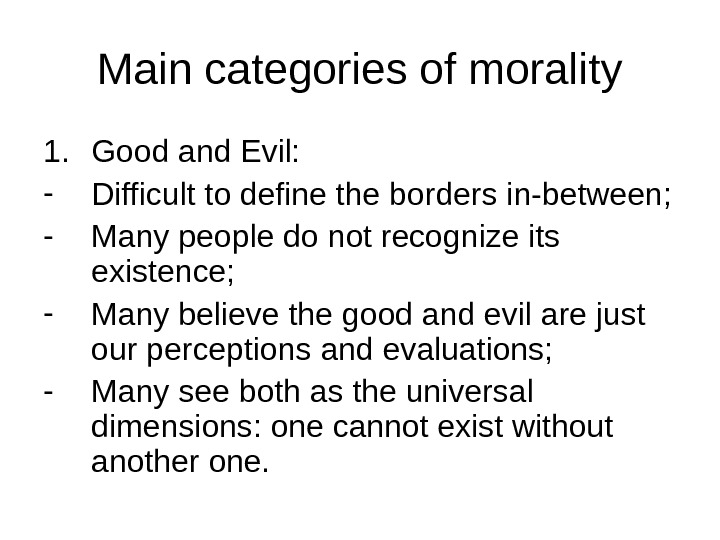

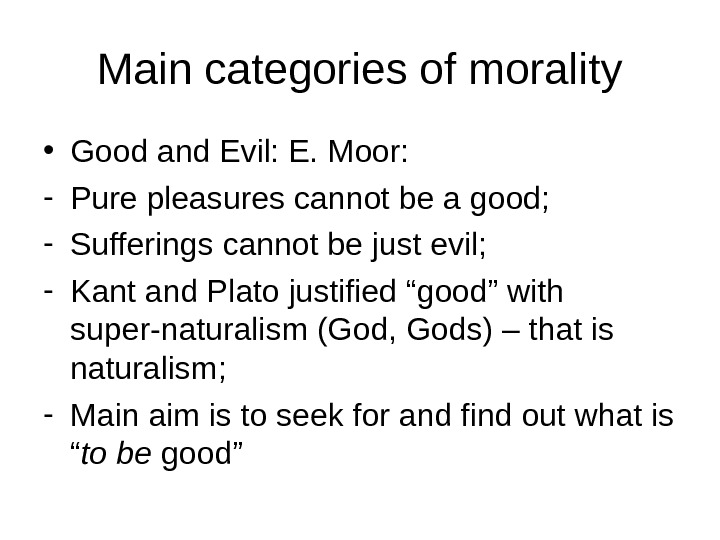
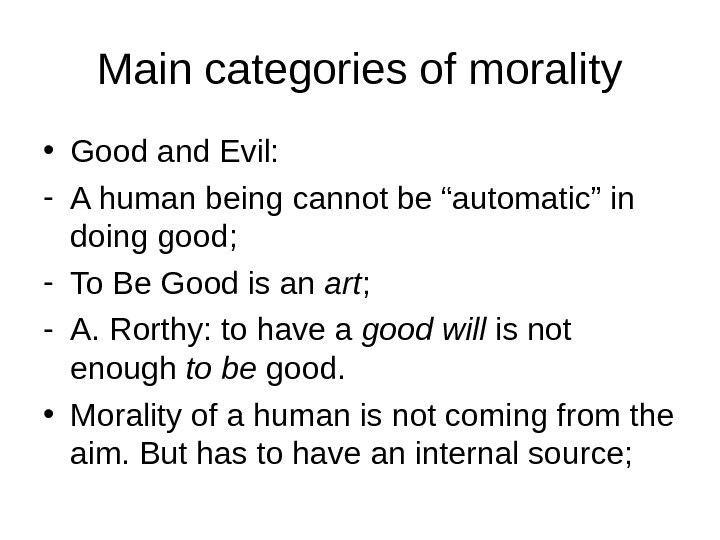
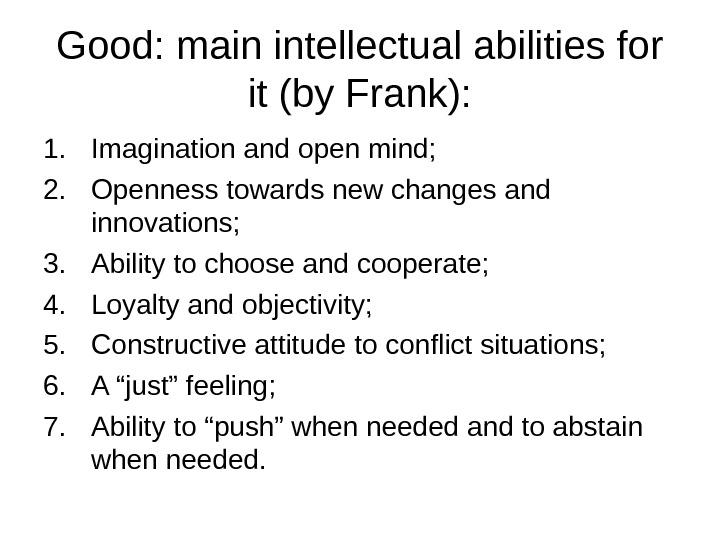

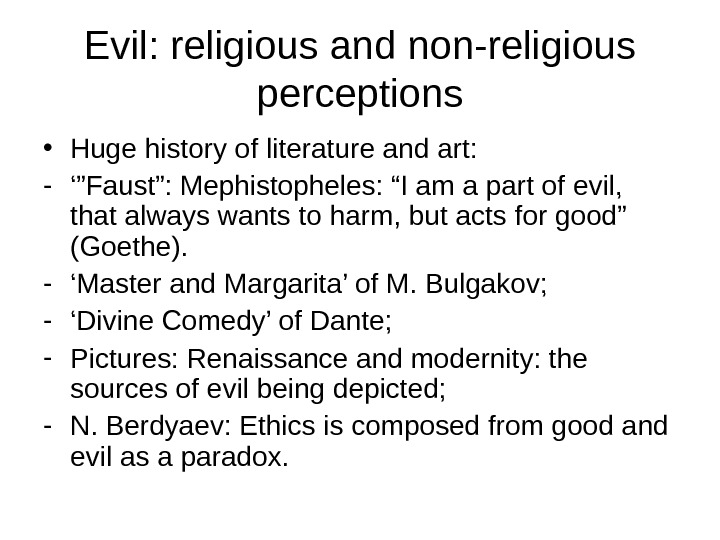
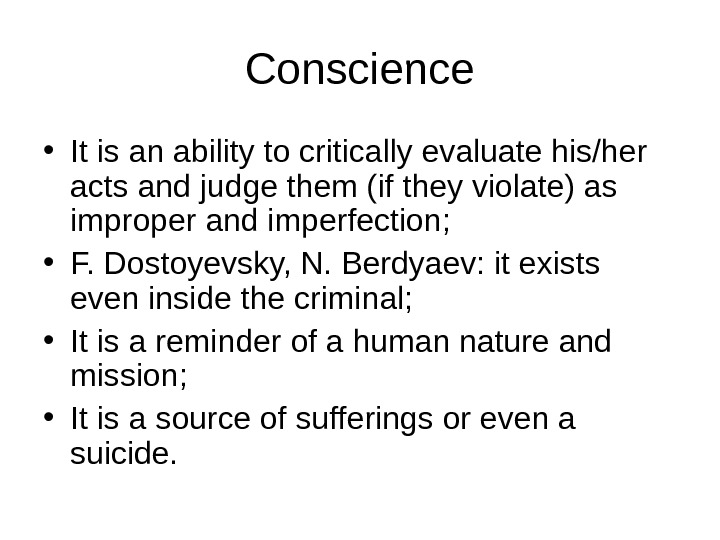
- Размер: 28.5 Кб
- Количество слайдов: 9
Описание презентации Main categories of morality Main categories of по слайдам
 Main categories of morality
Main categories of morality
 Main categories of morality 1. Good and Evil: — Difficult to define the borders in-between; — Many people do not recognize its existence; — Many believe the good and evil are just our perceptions and evaluations; — Many see both as the universal dimensions: one cannot exist without another one.
Main categories of morality 1. Good and Evil: — Difficult to define the borders in-between; — Many people do not recognize its existence; — Many believe the good and evil are just our perceptions and evaluations; — Many see both as the universal dimensions: one cannot exist without another one.
 Main categories of morality • Good and Evil — What is good? : fundamental question of ethics; — Honesty, virtues; pleasure – are all these Good? — Activities: “a good act”; “a good guy”, etc. — E. Moor: “A mistake of a complete mixture of qualities and objects”.
Main categories of morality • Good and Evil — What is good? : fundamental question of ethics; — Honesty, virtues; pleasure – are all these Good? — Activities: “a good act”; “a good guy”, etc. — E. Moor: “A mistake of a complete mixture of qualities and objects”.
 Main categories of morality • Good and Evil: E. Moor: — Pure pleasures cannot be a good; — Sufferings cannot be just evil; — Kant and Plato justified “good” with super-naturalism (God, Gods) – that is naturalism; — Main aim is to seek for and find out what is “ to be good”
Main categories of morality • Good and Evil: E. Moor: — Pure pleasures cannot be a good; — Sufferings cannot be just evil; — Kant and Plato justified “good” with super-naturalism (God, Gods) – that is naturalism; — Main aim is to seek for and find out what is “ to be good”
 Main categories of morality • Good and Evil: — A human being cannot be “automatic” in doing good; — To Be Good is an art ; — A. Rorthy: to have a good will is not enough to be good. • Morality of a human is not coming from the aim. But has to have an internal source;
Main categories of morality • Good and Evil: — A human being cannot be “automatic” in doing good; — To Be Good is an art ; — A. Rorthy: to have a good will is not enough to be good. • Morality of a human is not coming from the aim. But has to have an internal source;
 Good: main intellectual abilities for it (by Frank): 1. Imagination and open mind; 2. Openness towards new changes and innovations; 3. Ability to choose and cooperate; 4. Loyalty and objectivity; 5. Constructive attitude to conflict situations; 6. A “just” feeling; 7. Ability to “push” when needed and to abstain when needed.
Good: main intellectual abilities for it (by Frank): 1. Imagination and open mind; 2. Openness towards new changes and innovations; 3. Ability to choose and cooperate; 4. Loyalty and objectivity; 5. Constructive attitude to conflict situations; 6. A “just” feeling; 7. Ability to “push” when needed and to abstain when needed.
 Evil — The same force as good (belief in God and Devil); — Evil is an absence of good; — Evil often comes from human, his freedom to act not in a good way. — F. Dostoyevsky: ability to do evil – is a ‘depth’ of spirit of a human being, as well as committing good. — J. Boudreares: “Transparency of Evil”;
Evil — The same force as good (belief in God and Devil); — Evil is an absence of good; — Evil often comes from human, his freedom to act not in a good way. — F. Dostoyevsky: ability to do evil – is a ‘depth’ of spirit of a human being, as well as committing good. — J. Boudreares: “Transparency of Evil”;
 Evil: religious and non-religious perceptions • Huge history of literature and art: — ‘” Faust”: Mephistopheles: “I am a part of evil, that always wants to harm, but acts for good” (Goethe). — ‘ Master and Margarita’ of M. Bulgakov; — ‘ Divine Comedy’ of Dante; — Pictures: Renaissance and modernity: the sources of evil being depicted; — N. Berdyaev: Ethics is composed from good and evil as a paradox.
Evil: religious and non-religious perceptions • Huge history of literature and art: — ‘” Faust”: Mephistopheles: “I am a part of evil, that always wants to harm, but acts for good” (Goethe). — ‘ Master and Margarita’ of M. Bulgakov; — ‘ Divine Comedy’ of Dante; — Pictures: Renaissance and modernity: the sources of evil being depicted; — N. Berdyaev: Ethics is composed from good and evil as a paradox.
 Conscience • It is an ability to critically evaluate his/her acts and judge them (if they violate) as improper and imperfection; • F. Dostoyevsky, N. Berdyaev: it exists even inside the criminal; • It is a reminder of a human nature and mission; • It is a source of sufferings or even a suicide.
Conscience • It is an ability to critically evaluate his/her acts and judge them (if they violate) as improper and imperfection; • F. Dostoyevsky, N. Berdyaev: it exists even inside the criminal; • It is a reminder of a human nature and mission; • It is a source of sufferings or even a suicide.
